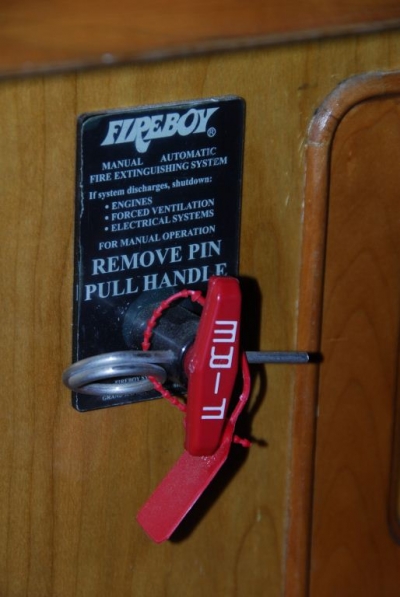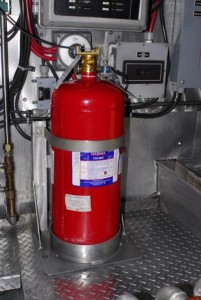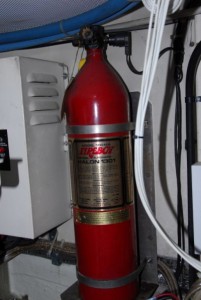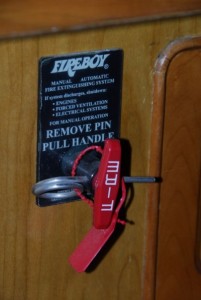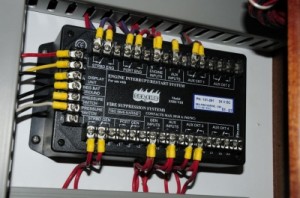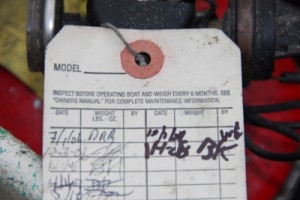Fixed Fire Suppression Systems Text and photos by Steve D’Antonio
Copyright 2012
Fixed fire suppression systems offer those who have them substantial peace of mind.While the systems themselves are relatively simple, issues often arise when installation instructions are not followed.The above unit is securely mounted and near the centerline of the vessel, however, its nozzle, which includes a temperature sensitive trigger, should be located has close to the overhead as possible.
When it comes to cruising challenges, thankfully there are but a few that can be placed in the “catastrophe” category.Flooding is of course one, being run down by another vessel ranks pretty high up there as well, however, it’s difficult to deny that fire is just about as bad as it gets.If you have a life raft or even a PFD, you have a chance at survival with disasters of the watery variety.There’s not much you can do, on the other hand, in the face of burning fiberglass resin or diesel fuel.
Fire extinguishers are clearly your best defense against this threat once it occurs (prevention is better still).As valuable and important as they are, portable fire extinguishers have two drawbacks.One, they must be used by a crewmember in very close proximity to the fire.Two, they are a manual only option. That is, they only work if activated by a person and that person must act quickly enough, discharging the fire extinguishing agent properly, in order for it to be effective.Fixed engine compartment fire extinguishers, on the other hand, provide the vessel operator with an automatic, and manual if so equipped, method of combating a fire that begins in the engineering spaces, which is where so many fires have their origins.
In its most basic form, a fixed fire extinguishing system consists of nothing more than a metallic cylinder, often referred to as a bottle, which contains a gaseous “clean’ fire extinguishing agent.The agent is typically FM 200 or FE241, only the former possesses a low enough toxicity to be used in normally occupied spaces.While it’s still acceptable and effective, Halon is no longer available thanks to its ozone depleting nature.The cylinder’s nozzle incorporates a glass vial that contains a liquid that expands when exposed to heat, usually about 175 degrees F.When the glass shatters, it allows a valve to open, which in turn discharges the gaseous agent in a fraction of a second.
Manual discharge is a worthwhile option for any fixed fire extinguishing system, enabling the user to discharge the bottle at the first sign of fire, rather than waiting for the temperature to reach the automatic discharge level.This manual discharge cable, installed aboard a new vessel, is not attached to the bottle, rendering it useless.
This clean agent has the added advantage of leaving behind no residue, such as that which remains after a dry chemical extinguisher is used, which in itself may be harmful to mechanical and electrical equipment. Installation is an important aspect of ensuring reliability of these systems.Among other things, bottles should be installed as close to the engine compartment’s centerline and as high as possible.Because these units are triggered by heat, it’s important that they be exposed to the highest heat as soon as possible, and that will always occur at the engine room overhead.
Fixed fire suppression system installation instructions should be followed to the letter, among other things, bottles should be securely mounted using through bolts rather than tapping screws, as well as being located high, on or close to the centerline and away from ventilation sources.
Additionally, units should not be installed near or under air intake vents.In the event of a fire, air will be drawn into the space through these vents and in the process act as a cooling agent for the bottle’s temperature sensitive trigger, which will in turn prolong the time before it discharges.
Among other things, you should ensure that your system’s capacity is appropriately sized for the compartment it’s being called upon to protect.Calculate your engine compartment volume, excluding the fuel tanks only, and then compare it to the label affixed to the system’s bottle, every one of which includes its coverage in cubic feet or meters. Yours should be capable of covering the space, however, over or under sizing are both discouraged; the latter for obvious reasons, the former for a more subtle reason.Systems designed to be used in occupied spaces, those that use agents safe for people, FM 200 for instance, only retain that attribute for the proper concentration in a given volume.If they are oversized, higher agent concentration could become lethal.
Because they are often quite heavy, fixed fire extinguishers must be severely mounted to bulkheads or overheads, preferably with through rather than lag bolts.If you can’t hang on it, it’s likely not installed securely enough, and I don’t mean this in a figurative manner.If you are making your way through your engine compartment and you lose your balance and the nearest handhold is the fire fixed fire extinguisher, it should be able to support your weight.
A worthwhile option that is available with nearly every fixed fire extinguishing system enables a crewmember to discharge the contents of the bottle at the first sign of fire, rather than waiting for automatic discharge to occur at 175 degrees F.Imagine you see smoke drifting out from around the main engine compartment access hatch or cockpit locker.If your system is equipped with an optional manual discharge, usually a red T handle located near the helm or in the saloon, you can pull the safety pin, yank on the handle and discharge the bottle without delay.
Manual discharge handles should easy to access, and located in plain view rather than in a locker or cabinet.If they are installed in a locker, a placard should be applied to the locker door indicating their presence within.
If it turns out to be a false alarm, other than the cost of refilling the bottle, there’s no harm done because the clean agent won’t damage an engine (running or idle) or any other gear.Whenever the system is discharged, whether manually or automatically, the engine, generator and ventilation blowers should be shut down immediately in order to maximize the effectiveness of the gaseous fire extinguishing agent.If you desire the ultimate in fire protection with full automation, an optional relay box is available for use with most fixed fire extinguishing systems.It will shut down any “air breathing” equipment such as engines, generators and blowers to which it’s attached as soon as the system discharges.
Automatic engine, generator and ventilation system shut down relay systems add complexity to a fixed fire suppression system, however, they are well worth the added effort.In order to remain ABYC compliant, this option is a necessity on diesel-powered vessels.
Fixed fire suppression systems should be periodically inspected, typically annually, to ensure they are in good working order.However, in my experience, many inspection services have little or no experience with marine installations.In many cases I’ve encountered inspectors who simply look at the bottle, initial the tag and hand over a bill.
Systems should be periodically inspected by a professional.However, marine systems differ from typical portable fire extinguishers and not all inspection outfits understand or are able to scrutinize marine installations.Just because the inspection tag is initialed it does not mean the system has been properly inspected.
Before contracting with one inquire as to their level of familiarity with yacht systems.Ask them if they have installed fixed fire suppression systems aboard yachts, and if are capable of testing the system’s automatic engine and ventilation system interface as well as the manual discharge cable, along with unshipping and weighing the bottle. Ask as well if they are able to evaluate the system to ensure it complies fully with all of the manufacturer’s installation requirements. If the answer is ‘no’ to any of these questions, contact the system’s manufacturer and ask them to recommend a marine qualified inspection service.
For more information on the services provided by Steve D’Antonio Marine Consulting, Inc. please e mail Steve at info@stevedmarineconsulting.com
or call 804-776-0981

